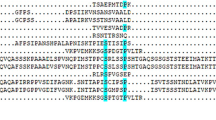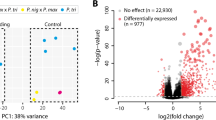Abstract
Trypsin inhibitors (TIs) play important roles in plant defense against biotic stresses. In this work, we first characterized the KTI gene families in the herbaceous model system, Arabidopsis thaliana, and the woody model system, Populus trichocarpa. Genomic analysis of AtKTIs and PtKTIs including phylogenetic relationship, gene structure, and motif preservation was presented. The temporal and spatial expression pattern of AtKTI genes under biotic and abiotic stresses has been performed by mining the publicly available microarray data. Unlike Populus, the absence of AtKTI induction under herbivore attack suggested that AtKTIs may not be closely related to herbivore defense in this plant species. In order to assess the potential of PtKTI as target genes for genetic improvement of the biotic resistance in plant species of high economic impact, we isolated KTI complementary DNAs from Populus nigra on a genome-wide scale and analyzed their respective response to Apocheima cinerarius Erschoff and mechanical wounding. A basically similar subset of PnKTIs was shown to be rapidly induced by both treatments in this study, though quantitatively distinct. This study revealed a different collection of wound- and herbivore-induced P. nigra KTI genes from those reported previously for hybrid poplar infested with Malacosoma disstri. Our data demonstrated that Populus could deploy KTI genes actively and selectively in an insect-specific manner. While KTI genes constitute good candidates for genetic engineering to improve biotic resistance in transgenic plant, their selection should be herbivore-oriented to obtain sufficient effects.







Similar content being viewed by others
References
Altschul SF, Madden TL, Schäffer AA, Zhang J, Zhang Z, Miller W, Lipman DJ (1997) Gapped BLAST and PSI-BLAST: a new generation of protein database search programs. Nucleic Acids Res 25:3389–3402
Bailey TL, Elkan C (1994) Fitting a mixture model by expectation maximization to discover motifs in biopolymers. Proceedings of the Second International Conference on Intelligent Systems for Molecular Biology, pp. 28–36. AAAI, Menlo Park
Balestrazzi A, Confalonieri M, Odoardi M, Ressegotti V, Allegro G, Tava A, Carbonera D (2004) A trypsin inhibitor cDNA from a novel source, snail medic (Medicago scutellata L.): cloning and functional expression in response to wounding, herbivore, jasmonic and salicylic acid. Plant Sci 167:337–346
Birk Y (1996) Protein proteinase inhibitors in legume seeds—overview. Arch Latinoam Nutr 44:26S–30S
Bode W, Huber R (1992) Natural protein proteinase inhibitors and their interaction with proteinases. Eur J Biochem 204:433–451
Bradshaw HD Jr, Hollick JB, Parsons TJ, Clarke HR, Gordon MP (1990) Systemically wound-responsive genes in poplar trees encode proteins similar to sweet potato sporamins and legume Kunitz trypsin inhibitors. Plant Mol Biol 14:51–59
Chenna R, Sugawara H, Koike T, Lopez R, Gibson TJ, Higgins DG, Thompson JD (2003) Multiple sequence alignment with the Clustal series of programs. Nucleic Acids Res 31:3497–3500
Christeller JT (2005) Evolutionary mechanisms acting on proteinase inhibitor variability. FEBS J 272:5710–5722
Christopher ME, Miranda M, Major IT, Constabel CP (2004) Gene expression profiling of systemically wound-induced defenses in hybrid poplar. Planta 219:936–947
Constabel CP, Yip L, Patton JJ, Christopher ME (2000) Polyphenol oxidase from hybrid poplar. Cloning and expression in response to wounding and herbivory. Plant Physiol 124:285–295
De Leo F, Bonade-Bottino M, Ceci LR, Gallerani R, Jouanin L (2001) Effects of a mustard trypsin inhibitor expressed in different plants on three lepidopteran pests. Insect Biochem Mol Biol 31:593–602
Dombrowski JE (2003) Salt stress activation of wound-related genes in tomato plants. Plant Physiol 132:2098–2107
do Socorro MCM, Oliva ML, Fritz H, Jochum M, Mentele R, Sampaio M, Coelho LC, Batista IF, Sampaio CA (2002) Characterization of a Kunitz trypsin inhibitor with one disulfide bridge purified from Swartzia pickellii. Biochem Biophys Res Commun 291:635–639
Gatehouse AM, Norton E, Davison GM, Babbe SM, Newell CA, Gatehouse JA (1999) Digestive proteolytic activity in larvae of tomato moth, Lacanobia oleracea; effects of plant protease inhibitors in vitro and in vivo. J Insect Physiol 45:545–558
Giri AP, Harsulkar AM, Deshpande VV, Sainani MN, Gupta VS, Ranjekar PK (1998) Chickpea defensive proteinase inhibitors can be inactivated by podborer gut proteinases. Plant Physiol 116:393–401
Green TR, Ryan CA (1972) Wound-induced proteinase inhibitor in plant leaves: a possible defense mechanism against insects. Science 175:776–777
Hall TA (1999) BioEdit: a user-friendly biological sequence alignment editor and analysis program for Windows 95/98/NT. Nucleic Acids Symp Ser 41:95–98
Haruta M, Major IT, Christopher ME, Patton JJ, Constabel CP (2001) A Kunitz trypsin inhibitor gene family from trembling aspen (Populus tremuloides Michx.): cloning, functional expression, and induction by wounding and herbivory. Plant Mol Biol 46:347–359
Heidel AJ, Baldwin IT (2004) Microarray analysis of salicylic acid- and jasmonic acid-signalling in responses of Nicotiana attenuata to attack by insects from multiple feeding guilds. Plant Cell Environ 27:1362–1373
Jongsma MA, Bakker PL, Peters J, Bosch D, Stiekema WJ (1995) Adaptation of Spodoptera exigua larvae to plant proteinase inhibitors by induction of gut proteinase activity insensitive to inhibition. Proc Natl Acad Sci USA 92:8041–8045
Kalluri UC, Difazio SP, Brunner AM, Tuskan GA (2007) Genome-wide analysis of Aux/IAA and ARF gene families in Populus trichocarpa. BMC Plant Biol 7:59
Lecharny A, Boudet N, Gy I, Aubourg S, Kreis M (2003) Introns in, introns out in plant gene families: a genomic approach of the dynamics of gene structure. J Struct Funct Genomics 3:111–116
Livak KJ, Schmittgen TD (2001) Analysis of relative gene expression data using real-time quantitative PCR and the 2(-Delta Delta C(T)) method. Methods 25:402–408
Lopes AR, Juliano MA, Juliano L, Terra WR (2004) Coevolution of insect trypsins and inhibitors. Arch Insect Biochem Physiol 55:140–152
Lurin C, Andres C, Aubourg S, Bellaoui M, Bitton F, Bruyere C, Caboche M, Debast C, Gualberto J, Hoffmann B et al (2004) Genome-wide analysis of Arabidopsis pentatricopeptide repeat proteins reveals their essential role in organelle biogenesis. Plant Cell 16:2089–2103
Major IT, Constabel CP (2006) Molecular analysis of poplar defense against herbivory: comparison of wound- and insect elicitor-induced gene expression. New Phytol 172:617–635
Major IT, Constabel CP (2008) Functional analysis of the Kunitz trypsin inhibitor family in poplar reveals biochemical diversity and multiplicity in defense against herbivores. Plant Physiol 146:888–903
Miranda M, Ralph SG, Mellway R, White R, Heath MC, Bohlmann J, Constabel CP (2007) The transcriptional response of hybrid poplar (Populus trichocarpa × P. deltoides) to infection by Melampsora medusae leaf rust involves induction of flavonoid pathway genes leading to the accumulation of proanthocyanidins. Mol Plant Microbe Interact 20:816–831
Oliva ML, Souza-Pinto JC, Batista IF, Araujo MS, Silveira VF, Auerswald EA, Mentele R, Eckerskorn C, Sampaio MU, Sampaio CA (2000) Leucaena leucocephala serine proteinase inhibitor: primary structure and action on blood coagulation, kinin release and rat paw edema. Biochim Biophys Acta 1477:64–74
Otlewski J, Krowarsch D, Apostoluk W (1999) Protein inhibitors of serine proteinases. Acta Biochim Pol 46:531–565
Philippe RN, Ralph SG, Kulheim C, Jancsik SI, Bohlmann J (2009) Poplar defense against insects: genome analysis, full-length cDNA cloning, and transcriptome and protein analysis of the poplar Kunitz-type protease inhibitor family. New Phytol 184:865–884
Rawlings ND, Tolle DP, Barrett AJ (2004) Evolutionary families of peptidase inhibitors. Biochem J 378:705–716
Reymond P, Weber H, Damond M, Farmer EE (2000) Differential gene expression in response to mechanical wounding and insect feeding in Arabidopsis. Plant Cell 12:707–720
Reymond P, Bodenhausen N, Van Poecke RM, Krishnamurthy V, Dicke M, Farmer EE (2004) A conserved transcript pattern in response to a specialist and a generalist herbivore. Plant Cell 16:3132–3147
Ryan CA (1990) Protease inhibitors in plants: genes for improving defenses against insects and pathogens. Annu Ver Phytopathol 28:425–449
Saarikoski P, Clapham D, von Arnold S (1996) A woundinducible gene from Salix viminalis coding for a trypsin inhibitor. Plant Mol Biol 31:465–478
Shewry PR, Lucas JA (1997) Plant proteins that confer resistance to pests and pathogens. Adv Botan Res 26:135–192
Sonnhammer EL, Eddy SR, Durbin R (1997) Pfam: a comprehensive database of protein domain families based on seed alignments. Proteins 28:405–420
Takabayashi J, Takahashi S, Dicke M, Posthumus MA (1995) Developmental stage of herbivore Pseudaletia separata affects production of herbivore-induced synomone by corn plants. J Chem Ecol 21:273–287
Talyzina NM, Ingvarsson PK (2006) Molecular evolution of a small gene family of wound inducible Kunitz trypsin inhibitors in Populus. J Mol Evol 63:108–119
Tamura K, Dudley J, Nei M, Kumar S (2007) MEGA4: molecular evolutionary genetics analysis (MEGA) software version 4.0. Mol Biol Evol 24:1596–1599
Tuskan GA, Difazio S, Jansson S, Bohlmann J, Grigoriev I, Hellsten U, Putnam N, Ralph S, Rombauts S, Salamov A et al (2006) The genome of black cottonwood, Populus trichocarpa (Torr. & Gray). Science 313:1596–1604
Valdes-Rodriguez S, Blanco-Labra A, Gutierrez-Benicio G, Boradenenko A, Herrera-Estrella A, Simpson J (1999) Cloning and characterization of a trypsin inhibitor cDNA from amaranth (Amaranthus hypochondriacus) seeds. Plant Mol Biol 41:15–23
Voelckel C, Baldwin IT (2004) Generalist and specialist lepidopteran larvae elicit different transcriptional responses in Nicotiana attenuata, which correlate with larval FAC profiles. Ecol Lett 7:770–775
Xue T, Wang D, Zhang S, Ehlting J, Ni F, Jakab S, Zheng C, Zhong Y (2008) Genome-wide and expression analysis of protein phosphatase 2C in rice and Arabidopsis. BMC Genomics 9:550
Acknowledgments
This study was supported by the National Natural Science Foundation of China (No. 30800875), Tianjin Research Program of Application Foundation and Advanced Technology (10JCYBJC08600), and the Ph.D. Programs Foundation of the Ministry of Education of China (No. 200800561034).
Author information
Authors and Affiliations
Corresponding author
Additional information
Communicated by W. Boerjan
Yuan Ma and Qing Zhao contributed to this paper equally.
Electronic supplementary material
Below is the link to the electronic supplementary material.
Supplementary Table 1
Primers used in genome cloning and quantifying PCR analysis (DOC 61 kb)
Supplementary Table 2
Kunitz-type trypsin inhibitor genes in Populus trichocarpa (DOC 91 kb)
Supplementary Table 3
Stress treatment method used in microarray analysis of AtKTIs (DOC 92 kb)
Supplementary Figure 1
Phylogenetic relationships of Arabidopsis thaliana, Populus trichocarpa, Oryza sativa, and Sorghum vulgare Kunitz-type trypsin inhibitor genes. Sequence phylogram was constructed by neighborhood-joining bootstrap method using ClustalX1.8 software based on the multiple alignments of the protein amino acid sequences of all the KTIs, and the radial tree was generated using TreeView software (Win 32, Version 1.6.6) (DOC 1544 kb)
Supplementary Figure 2
Distribution of KTI genes on P. trichocarpa chromosomes. The names of the chromosomes are indicated below each chromosome. Segmental duplicated homologous blocks on Populus (Kalluri et al. 2007) were indicated with the same color. The position of genes was indicated with a line. Chomosomal duplication gene was connected with a single line. Tandem duplication was marked by a vertical bar (DOC 491 kb)
Supplementary Figure 3
Clustal X alignments of the amino acid sequences of KTIs from Populus nigra. The highly conserved motif was indicated by gray shadow or uplined (DOC 3344 kb)
Rights and permissions
About this article
Cite this article
Ma, Y., Zhao, Q., Lu, MZ. et al. Kunitz-type trypsin inhibitor gene family in Arabidopsis and Populus trichocarpa and its expression response to wounding and herbivore in Populus nigra . Tree Genetics & Genomes 7, 431–441 (2011). https://doi.org/10.1007/s11295-010-0345-3
Received:
Revised:
Accepted:
Published:
Issue Date:
DOI: https://doi.org/10.1007/s11295-010-0345-3




